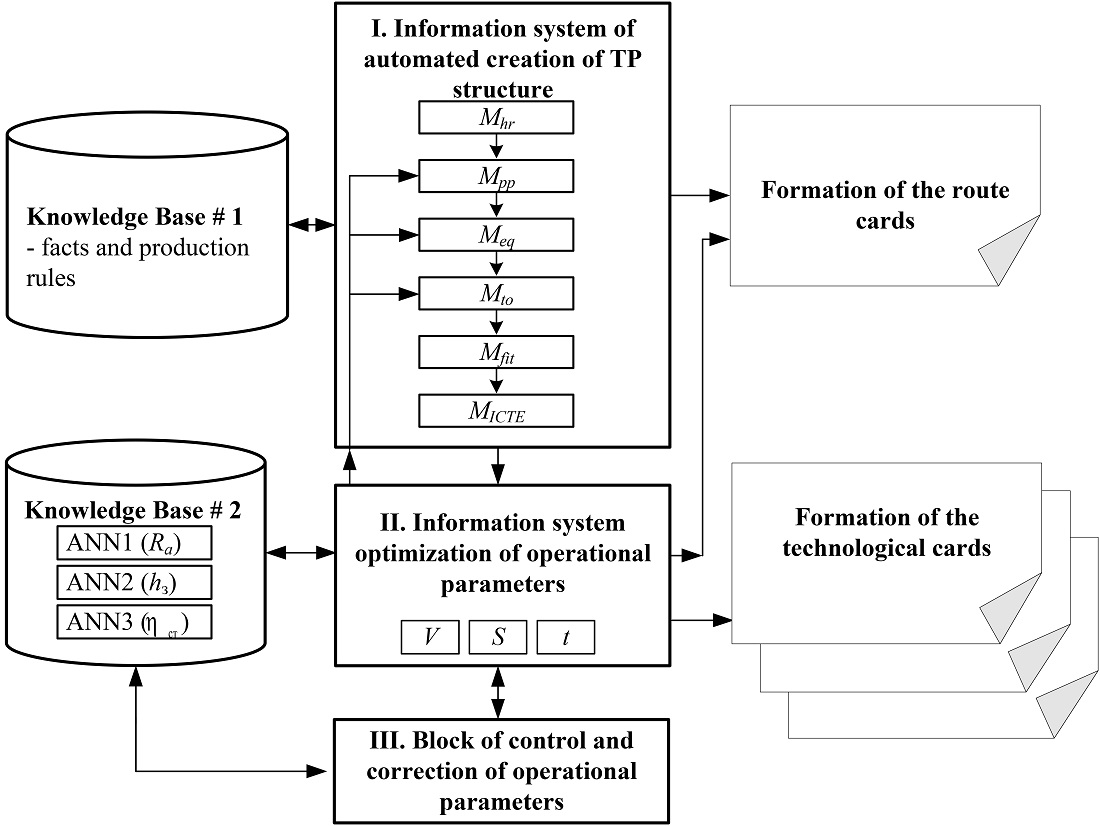Розробка системи підтримки прийняття рішень для створення оптимальних технологічних процесів механообробки деталей на основі методів штучного інтелекту
DOI:
https://doi.org/10.15587/1729-4061.2024.306611Ключові слова:
автоматизація, технологічний процес, механообробка, штучний інтелект, багатокритеріальна постановка, Парето-оптимальне рішенняАнотація
Об’єктом дослідження є процес створення системи підтримки прийняття рішень для автоматизації створення технологічних процесів (ТП) механообробки деталей високоточного обладнання для авіаційної промисловості.
Вирішене завдання підвищення ефективності оптимізації процесу механообробки деталей за рахунок використання системи підтримки прийняття рішень (СППР) та методів штучного інтелекту, які на відміну від відомих аналітичних підходів, дозволяють описати процеси і явища, що не мають строгої формалізації. СППР складається з трьох підсистем. Перша – інформаційна підсистема автоматизованого створення структури технологічного процесу механообробки деталей високоточного обладнання. Друга – інформаційна підсистема оптимізації параметрів операцій ТП обробки різанням з урахуванням накопичення зносу інструменту. Третя – підсистема контролю та корегування операційних параметрів.
В процесі проведення досліджень розроблений підхід щодо проєктування оптимальних технологічних процесів механообробки деталей високоточного обладнання. Завдання проєктування структури технологічних процесів вирішується з використанням продукційних правил. Завдання визначення оптимальних параметрів операцій точіння і фрезерування вирішене в багатокритеріальній постановці. Як цільові функції використано: собівартість операції, питомі енерговитрати на операцію та продуктивність операції. При цьому враховується знос інструменту, що накопичується у часі. Рішення отримано шляхом пошуку Парето-оптимального рішення з використанням генетичних алгоритмів та штучних нейронних мереж.
В результаті роботи СППР було створено оптимальний технологічний процес механообробки деталей високоточного обладнання для авіаційної промисловості, що дозволило скоротити час виробництва однієї деталі на 5 %, а сумарну собівартість виробництва деталі зменшити на 14 %
Посилання
- Kozlova, E. V. (2011). Integrated decision support system for managing the structures of production processes. Eastern-European Journal of Enterprise Technologies, 3 (12 (51)), 45–50. Available at: https://journals.uran.ua/eejet/article/view/2469
- Chandrasekaran, M., Muralidhar, M., Krishna, C. M., Dixit, U. S. (2009). Application of soft computing techniques in machining performance prediction and optimization: a literature review. The International Journal of Advanced Manufacturing Technology, 46 (5-8), 445–464. https://doi.org/10.1007/s00170-009-2104-x
- Stupnytskyy, V. (2014). Structural-parametric optimization of the technological processes for the assurance of part’s service properties. Eastern-European Journal of Enterprise Technologies, 2 (3 (68)), 9–16. https://doi.org/10.15587/1729-4061.2014.23378
- Grzesik, W. (2017). Advanced Machining Processes of Metallic Materials. Theory, Modelling, and Applications. Elsevier.
- Krasyukova, N. L., Boyko, A. N., Plotitsyna, L. A., Zudenkova, S. A., Danilkevich, M. A. (2020). Intelligent Decision-Making Technology for Choice MVC Models using Neural Networks. International Journal of Advanced Trends in Computer Science and Engineering, 9 (3), 3184–3187. https://doi.org/10.30534/ijatcse/2020/107932020
- Mamtiyev, K., Rzayeva, U. (2024). Finding and implementing the numerical solution of an optimal control problem for oscillations in a coupled objects system. Eastern-European Journal of Enterprise Technologies, 2 (2 (128)), 64–74. https://doi.org/10.15587/1729-4061.2024.301714
- Mahdi, Q. A., Shyshatskyi, A., Babenko, V., Bieliakov, R., Odarushchenko, E., Protas, N. et al. (2024). Development of a solution search method using artificial intelligence. Eastern-European Journal of Enterprise Technologies, 2 (4 (128)), 38–47. https://doi.org/10.15587/1729-4061.2024.300261
- Owaid, S. R., Zhuravskyi, Y., Lytvynenko, O., Veretnov, A., Sokolovskyi, D., Plekhova, G. et al. (2024). Development of a method of increasing the efficiency of decision-making in organizational and technical systems. Eastern-European Journal of Enterprise Technologies, 1 (4 (127)), 14–22. https://doi.org/10.15587/1729-4061.2024.298568
- Sova, O., Turinskyi, O., Shyshatskyi, A., Dudnyk, V., Zhyvotovskyi, R., Prokopenko, Y. et al. (2020). Development of an algorithm to train artificial neural networks for intelligent decision support systems. Eastern-European Journal of Enterprise Technologies, 1 (9 (103)), 46–55. https://doi.org/10.15587/1729-4061.2020.192711
- Galchonkov, O., Nevrev, A., Glava, M., Babych, M. (2020). Exploring the efficiency of the combined application of connection pruning and source data preprocessing when training a multilayer perceptron. Eastern-European Journal of Enterprise Technologies, 2 (9 (104)), 6–13. https://doi.org/10.15587/1729-4061.2020.200819
- Rao, R. V. (2011). Advanced Modeling and Optimization of Manufacturing Processes. In Springer Series in Advanced Manufacturing. Springer London. https://doi.org/10.1007/978-0-85729-015-1
- Gorbiychuk, M., Kropyvnytskyi, D., Kropyvnytska, V. (2023). Improving empirical models of complex technological objects under conditions of uncertainty. Eastern-European Journal of Enterprise Technologies, 2 (2 (122)), 53–63. https://doi.org/10.15587/1729-4061.2023.276586
- von Lücken, C., Barán, B., Brizuela, C. (2014). A survey on multi-objective evolutionary algorithms for many-objective problems. Computational Optimization and Applications. https://doi.org/10.1007/s10589-014-9644-1
- Machining Power (Full). Іscar. Available at: https://mpwr.iscar.com/MachiningPower

##submission.downloads##
Опубліковано
Як цитувати
Номер
Розділ
Ліцензія
Авторське право (c) 2024 Viacheslav Lymarenko, Oleksandr Mozhaiev, Inna Khavina, Serhii Tiulieniev, Mykhailo Mozhaiev, Yurii Onishchenko, Yurii Gnusov, Mikhail Tsuranov, Volodymyr Homon

Ця робота ліцензується відповідно до Creative Commons Attribution 4.0 International License.
Закріплення та умови передачі авторських прав (ідентифікація авторства) здійснюється у Ліцензійному договорі. Зокрема, автори залишають за собою право на авторство свого рукопису та передають журналу право першої публікації цієї роботи на умовах ліцензії Creative Commons CC BY. При цьому вони мають право укладати самостійно додаткові угоди, що стосуються неексклюзивного поширення роботи у тому вигляді, в якому вона була опублікована цим журналом, але за умови збереження посилання на першу публікацію статті в цьому журналі.
Ліцензійний договір – це документ, в якому автор гарантує, що володіє усіма авторськими правами на твір (рукопис, статтю, тощо).
Автори, підписуючи Ліцензійний договір з ПП «ТЕХНОЛОГІЧНИЙ ЦЕНТР», мають усі права на подальше використання свого твору за умови посилання на наше видання, в якому твір опублікований. Відповідно до умов Ліцензійного договору, Видавець ПП «ТЕХНОЛОГІЧНИЙ ЦЕНТР» не забирає ваші авторські права та отримує від авторів дозвіл на використання та розповсюдження публікації через світові наукові ресурси (власні електронні ресурси, наукометричні бази даних, репозитарії, бібліотеки тощо).
За відсутності підписаного Ліцензійного договору або за відсутністю вказаних в цьому договорі ідентифікаторів, що дають змогу ідентифікувати особу автора, редакція не має права працювати з рукописом.
Важливо пам’ятати, що існує і інший тип угоди між авторами та видавцями – коли авторські права передаються від авторів до видавця. В такому разі автори втрачають права власності на свій твір та не можуть його використовувати в будь-який спосіб.










